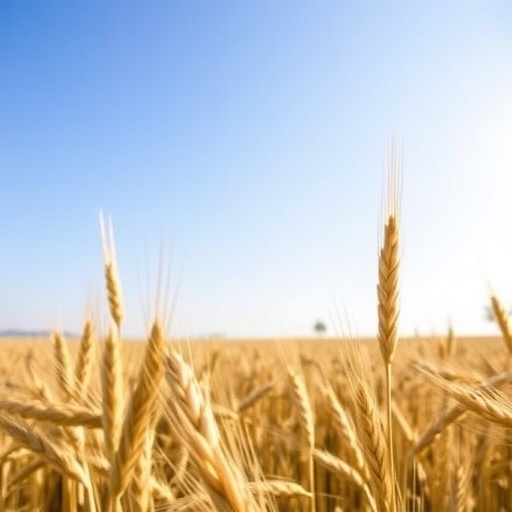In the evolving landscape of global agriculture, adapting to the accelerating pace of climate change poses formidable challenges. New research from Washington State University sheds crucial light on the limits of a commonly proposed adaptation strategy for spring wheat production in the United States: earlier planting. Contrary to optimistic assumptions that advancing planting dates could circumvent the detrimental impacts of rising summer temperatures, this detailed study reveals that earlier sowing fails to reproduce the favorable historical growing conditions necessary to sustain current yield levels under future climatic scenarios.
The foundational premise has long held that shifting planting schedules earlier in the spring might allow spring wheat to complete key developmental phases before the onset of increasingly harsh summer heat, thereby protecting yields from thermal stress. However, using sophisticated computational simulation tools, the Washington State research team meticulously modeled the phenological responses and temperature exposure of spring wheat across diverse northern U.S. agroecological zones. Their results expose a complex interplay of plant growth dynamics and environmental factors that challenge the simplicity of the earlier-planting fix.
Specifically, the simulations demonstrated that planting wheat earlier in the spring often subjects the developing crop to a broader spectrum of temperature extremes outside the peak summer period. These suboptimal temperature exposures during critical growth phases, including cold snaps at emergence and elevated temperatures at other sensitive intervals, can collectively impair physiological processes, stunting growth and ultimately reducing grain yields. The phenomenon underscores a crucial tradeoff: while early planting may decrease heat stress during some stages, it simultaneously heightens cold or heat stresses at others, complicating the crop’s thermal niche.
Another significant finding of the research concerns the compression of the planting window imposed by earlier sowing. Current USDA-based guidelines indicate that spring wheat planting typically spans an approximately eleven-week period across U.S. production regions. The study indicates that climate-driven earlier sowing would dramatically narrow this window to as little as one to seven weeks, with major implications for farm management. This shortened timeframe presents logistical challenges, escalating pressures on labor and machinery availability, and increasing vulnerability to adverse weather events during planting operations.
The cumulative effect of these physiological and practical constraints paints a sobering picture for U.S. spring wheat production. The research predicts that earlier planting alone, as a climate adaptation strategy, is insufficient to uphold historical productivity levels in the face of intensifying warming trends. Importantly, these findings were consistent across multiple northern wheat-growing regions, except in the Pacific Northwest. The study identified this region as having a somewhat expanded thermal tolerance range, making it more resilient to the risks associated with earlier planting.
This research was spearheaded by Kirti Rajagopalan, assistant professor in Washington State University’s Department of Biological Systems Engineering, and her graduate student Supriya Savalkar. Collaborating with experts in wheat breeding and crop sciences, the team leveraged high-performance computational models to simulate crop growth responses under a variety of climatic scenarios. Their approach integrated regional planting windows and temperature data to systematically evaluate how timing adjustments influence heat exposure during different developmental stages.
The broader implications extend into wheat breeding and cultivar development efforts. Mike Pumphrey, WSU’s O.A. Vogel Chair of Spring Wheat Breeding and Genetics and co-author of the study, emphasized the necessity of breeding wheat varieties that can mature earlier in the season without sacrificing yield potential. Breeding programs must now reckon with rapidly changing climate norms and seek genotypes that thrive within narrowing planting windows and shifting thermal environments—a challenging but urgent endeavor.
The study’s nuanced insights caution against oversimplified adaptation strategies that rely solely on phenological shifts to escape climate stressors. Instead, the researchers advocate a holistic approach that includes genetic improvement, refined planting practices, and comprehensive climate risk assessments. “Earlier planting should be one component of a multifaceted response,” said Rajagopalan. “We need to deepen our understanding of how temperature dynamics throughout the growing season interact with plant physiology to develop more resilient cropping systems.”
Moreover, the research recognizes the socio-economic dimensions embedded within such agronomic changes. Narrower planting windows could disproportionately affect smallholder and resource-limited farmers who may lack the capacity to adjust machinery schedules or labor deployments quickly. Ensuring equitable access to varieties suited for future conditions and supporting adaptive capacity in farming communities is vital for sustainable agricultural transitions.
This work importantly challenges a widely held assumption in climate-agriculture discourse, highlighting how empirical data and advanced modeling can unveil hidden complexities in crop-climate interactions. The findings prompt a recalibration of expectations surrounding climate adaptation via simple phenological adjustments and underscore the importance of region-specific strategies. The relative resilience of the Pacific Northwest further points to the critical role of local environmental factors in shaping adaptive potential.
The paper, published in Communications Earth & Environment, makes a compelling scientific case: earlier planting, while intuitively appealing, cannot alone counterbalance the multifaceted impacts of climate warming on U.S. spring wheat productivity. It opens compelling avenues for future research and policy development focused on integrating crop modeling with breeding innovation and farm management optimization to safeguard food security in a warming world.
As climate models project continued temperature increases and growing season shifts, this study serves as a clarion call for the agricultural research community and stakeholders to rethink adaptation paradigms. Ensuring the sustainability of staple crop production demands nuanced, data-driven approaches that embrace complexity rather than oversimplification—recognizing that the path forward must navigate a tightrope of environmental constraints with both scientific rigor and practical sensibility.
—
Subject of Research: Not applicable
Article Title: Earlier planting fails to replicate historical production conditions for US spring wheat under future climates
News Publication Date: 27-Aug-2025
Web References: http://dx.doi.org/10.1038/s43247-025-02716-0
References: Rajagopalan, K., Savalkar, S., et al., Communications Earth & Environment, 2025.
Image Credits: Photo Scott Weybright/Washington State University
Keywords: spring wheat, climate change, earlier planting, crop productivity, temperature stress, crop simulation, phenology, planting windows, wheat breeding, agricultural adaptation, computational modeling, crop yield




